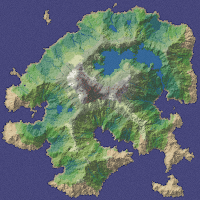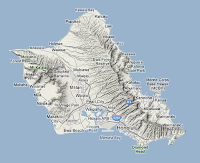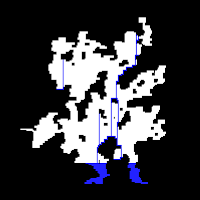Map Generator Using Voronoi Polygons
The first algorithm is a map generator based on Voronoi polygons rather than on square tiles. A Voronoi diagram is created by randomly placing points and creating polygons that have edges are no more than halfway to any other point. The most common way of generating a Voronoi diagram is using Fortune's Algorithm. The advantage of using polygons over tiles is that they produce a much more random and natural looking shape.
 |
| A Voronoi Diagram after 2 applications of Lloyd Relaxation |
The writer of this algorithm posted a flash demo, and there are source code examples in various languages listed near the bottom of the article.
 |
| The final result using 16,000 polygons [1] |
Well I find this technique works generally well I have also noticed a few problems. One problem is that the algorithm places all of the mountains in the center of the land mass and then has an even slope from the mountains to the coast. While this looks good for some small islands, in general mountains are not placed like this, for example the island of Oahu has mountains on the two sides of the island with a flat area in the middle. Another issue that I find common in most map generators is that they look good from a distance but lack details like sharp cliff faces and jagged peaks. Well this algorithm is a good start, these issues make me want to consider improvements.
 |
| A terrain map of Oahu from Google Maps |
Another technique is based on erosion and volcanic eruptions. The map would start with a randomly generated landmass and then randomly drop water on points and have these water drops move down hill toward water. This is similar to how rivers already work in this simulation, with the extension that overtime the rivers cause the steep edges to lower and the shallower edges to rise. This simulates how fast moving water erodes ground which slow moving water deposits. I believe this strategy would lead to steep valleys, canyons and smooth plains. I also believe that volcanic eruptions could be simulated in a similar way.
Cave Generator
I also read about another algorithm for creating caves. I find this algorithm interesting because it is similar to my algorithm for generating mazes but using a completely different technique.
The algorithm is very simple and is based on several agents that act as miners, digging out a tunnel. The algorithm starts with a single miner. The miner moves randomly to an uncleared tile and clears that tile. As it moves it randomly spawns additional miners. A miner dies when it is completely surrounded by empty tiles, unless there is only a single miner left in which case it continues to move randomly. The article does not mention an obvious stopping point but say that they stopped the algorithm after 400 miners had died. Once the algorithm has stopped it removes small unmined fragments and then adds water to the empty bottom tiles purely for aesthetic effect. [2]
The writer of this article also posted a flash demo.
 |
| The final result of the Algorithm [2] |
There are a couple of things that could be improved with this algorithm. The first is that it would be nice if the algorithm could be modified to produce longer more dispersed tunnels. Also, the algorithm is described as being on the vertical plane but the minors ignore gravity and the result is a mine that looks somewhat natural but if you were trying to generate a mine that looked like it was built by miners one would probably want to take gravity into account.
There are a couple of improvements that I would like to try with this algorithm. First, I think this would be interesting to try in 3 dimensions since adding an extra dimension would be trivial. Secondly, in nature many mines are carved out by water, so using technique based on erosion might also produce natural looking caves. Lastly, adding the concept of minerals could be used to direct the miners in a certain direction giving the designer some loose control over the random cave.
So those are two procedural generator that show that complex scenes can be constructed using some simple rules. I am very much interesting in trying to implemented a version of these algorithms. At the moment I am very busy with term projects and exams, but will hopefully have some free time after. Also, In the future as I find more interesting algorithms I will write a similar analysis of them and tag all of my procedural generation articles so they are easily to distinguish from my other articles.
Refereces
[1] Amit Patel. "Polygonal Map Generation for Games" Internet: http://www-cs-students.stanford.edu/%7Eamitp/game-programming/polygon-map-generation/, Sept 4, 2010 [April 7, 2012].
[2] Noel Berry. "Procedural Generation – The Caves" Internet: http://www.noelberry.ca/2011/04/procedural-generation-the-caves/, April 19, 2011 [April 7, 2012].
Hi Jordan,
ReplyDeleteI agree about the mountains. The earlier version of the polygon map generator had asymmetry but the game I was targeting (Realm of the Mad God) needed the mountains in the middle. Two approaches to try are either to use a variable slope that depends on direction (for example all eastward slopes are steeper) or to use variable density of the points that feed into the voronoi algorithm.
My previous map generators used erosion, volcanism, wind, rain shadows, plate tectonics, etc.. When the output was good, it was really good. But most of the time the output was mundane, and sometimes the output was bad for gameplay. For the polygon map generator I was instead optimizing for minimizing bad maps (ideally no bad maps would ever get generated), so that it could be used in an automated way without a human removing bad maps. I started with the needs of the game and went backwards to figure out how to generate a map that fit within those needs. It doesn't produce as realistic maps because it's optimize for gameplay and not realism. :)